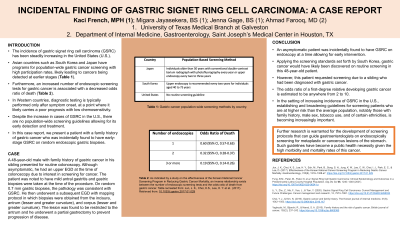Back


Poster Session D - Tuesday Morning
Category: Stomach
D0707 - Incidental Finding of Gastric Signet Ring Cell Carcinoma: A Case Report
Tuesday, October 25, 2022
10:00 AM – 12:00 PM ET
Location: Crown Ballroom

Has Audio

Kaci French, MPH
University of Texas Medical Branch
Galveston, TX
Presenting Author(s)
Kaci French, MPH1, Migara Jayasekera, BS1, Jenna Gage, BS1, Ahmad Farooq, MD2
1University of Texas Medical Branch, Galveston, TX; 2Duke University, Houston, TX
Introduction: The incidence of Gastric signet ring cell carcinoma (GSRC) has been on the rise in the United States (U.S.). GSRC is estimated to account for approximately 8% to 30% of all gastric cancers in the U.S., and despite this increase in cases, there are no population-wide screening guidelines allowing for early detection. It is notable that GSRC is typically not diagnosed until it has already reached an aggressive stage with a poor prognosis and low chemosensitivity. In this case, we present a patient with a family history of gastric cancer who was incidentally found to have early-stage GSRC on random gastric biopsies taken on endoscopy.
Case Description/Methods: A 48-year-old male with family history of gastric cancer in his sibling presented for routine colonscopy. Although asymptomatic, he had an upper esophagogastroduodenoscopy (EGD) at the time of colonoscopy due to interest in screening for cancer. The patient was noted to have mild antral gastritis and gastric biopsies were taken at the time of the procedure. On random 0.7 mm gastric biopsies, the pathology was consistent with GSRC. He then underwent a subsequent EGD with mapping protocol in which biopsies were obtained from the incisura, antrum (lesser and greater curvature), and corpus (lesser and greater curvature). The lesion was found to be restricted to the antrum and he underwent a partial gastrectomy to prevent progression of disease.
Discussion: This case describes an asymptomatic patient found to have GSRC on endoscopic biopsies at a time that allowed for early intervention. Currently, there are no definitive guidelines for screening gastric cancer or metaplastic changes in the U.S., placing the decision-making burden onto the physician. In the setting of increasing incidence of gastric cancer in the U.S., establishing and broadening guidelines for screening patients who are at higher risk than the average population, notably those with family history, male sex, tobacco use, and of certain ethnicities, is becoming increasingly important. The odds ratio of a first-degree relative developing gastric cancer is estimated to be anywhere from 2 to 10 depending on the corresponding risk factors and demographics of the patient. Further research is warranted for the development of screening protocols that can guide gastroenterologists on endoscopically screening for metaplastic or cancerous lesions of the stomach. Such guidelines have become a public health necessity given the astoundingly high morbidity and mortality rates of this cancer.
Disclosures:
Kaci French, MPH1, Migara Jayasekera, BS1, Jenna Gage, BS1, Ahmad Farooq, MD2. D0707 - Incidental Finding of Gastric Signet Ring Cell Carcinoma: A Case Report, ACG 2022 Annual Scientific Meeting Abstracts. Charlotte, NC: American College of Gastroenterology.
1University of Texas Medical Branch, Galveston, TX; 2Duke University, Houston, TX
Introduction: The incidence of Gastric signet ring cell carcinoma (GSRC) has been on the rise in the United States (U.S.). GSRC is estimated to account for approximately 8% to 30% of all gastric cancers in the U.S., and despite this increase in cases, there are no population-wide screening guidelines allowing for early detection. It is notable that GSRC is typically not diagnosed until it has already reached an aggressive stage with a poor prognosis and low chemosensitivity. In this case, we present a patient with a family history of gastric cancer who was incidentally found to have early-stage GSRC on random gastric biopsies taken on endoscopy.
Case Description/Methods: A 48-year-old male with family history of gastric cancer in his sibling presented for routine colonscopy. Although asymptomatic, he had an upper esophagogastroduodenoscopy (EGD) at the time of colonoscopy due to interest in screening for cancer. The patient was noted to have mild antral gastritis and gastric biopsies were taken at the time of the procedure. On random 0.7 mm gastric biopsies, the pathology was consistent with GSRC. He then underwent a subsequent EGD with mapping protocol in which biopsies were obtained from the incisura, antrum (lesser and greater curvature), and corpus (lesser and greater curvature). The lesion was found to be restricted to the antrum and he underwent a partial gastrectomy to prevent progression of disease.
Discussion: This case describes an asymptomatic patient found to have GSRC on endoscopic biopsies at a time that allowed for early intervention. Currently, there are no definitive guidelines for screening gastric cancer or metaplastic changes in the U.S., placing the decision-making burden onto the physician. In the setting of increasing incidence of gastric cancer in the U.S., establishing and broadening guidelines for screening patients who are at higher risk than the average population, notably those with family history, male sex, tobacco use, and of certain ethnicities, is becoming increasingly important. The odds ratio of a first-degree relative developing gastric cancer is estimated to be anywhere from 2 to 10 depending on the corresponding risk factors and demographics of the patient. Further research is warranted for the development of screening protocols that can guide gastroenterologists on endoscopically screening for metaplastic or cancerous lesions of the stomach. Such guidelines have become a public health necessity given the astoundingly high morbidity and mortality rates of this cancer.
Disclosures:
Kaci French indicated no relevant financial relationships.
Migara Jayasekera indicated no relevant financial relationships.
Jenna Gage indicated no relevant financial relationships.
Ahmad Farooq indicated no relevant financial relationships.
Kaci French, MPH1, Migara Jayasekera, BS1, Jenna Gage, BS1, Ahmad Farooq, MD2. D0707 - Incidental Finding of Gastric Signet Ring Cell Carcinoma: A Case Report, ACG 2022 Annual Scientific Meeting Abstracts. Charlotte, NC: American College of Gastroenterology.
